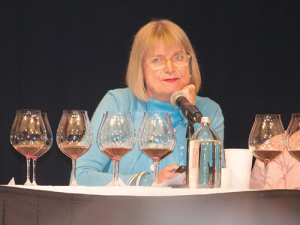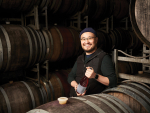Take whichever meaning you prefer and then relate it to wine.
On day two, that was the task at one of the sessions. How do we define greatness or quality in wine? Is there a universal ideal – is it possible?
Well if anything was going to get the delegates talking, this was it.
With a panel of (excuse the pun) great wine writers and makers, it quickly became obvious that greatness is very much a personal opinion.
Marcel Giesen from Giesen Wines and Bell Hill Vineyard, said a great wine “demands my attention. It raises my awareness through its balance, power, intensity, persistence, purity. It flows and it engages me. It draws me in, complex, compelling, authentic.”
In Australian wine writer Mike Bennie’s case, “what defines quality to me is more about emotional impact. Drinkability and understanding of interpretation of the winemaker’s intent. How wine gets to bottle is paramount. Quality in essence is a seesaw between usefulness and paradigm beauty.”
Japanese Master of Wine Kenichi Ohashi described great Pinot Noir as being, “transparent, with the best qualities of premium water.”
And finally Jancis Robinson MW said a great wine had “charm, refreshment, intrigue, balance, aging potential, development in the glass, terroir expression, persistence and memorability.”
See what I mean? There are a fair few differing opinions on what makes a wine great. But there are also a few consistent definitions. Terroir, balance, persistence were words that were repeated by more than one panelist.
In an effort to show how different each person’s perspective is when defining great –the four panelists were asked to nominate two wines that they felt supported their argument. The only criteria was, none could be from New Zealand, and there was a price limitation. (The wines and who chose them are listed to the right).
As delegates tasted their way through the wines, and the panelists explained why they had chosen them, discussions began on what criteria needs to be considered when defining greatness.
Jancis suggested that for a lot of people, “greatness equals greatness of price”.
Mike Bennie was quick to agree, stating that for “the pubic one of the greatest motivating factors is a red circle with a line through it with the original price and the new price below. I think that is a driving factor, followed by a pretty label.”
A question from the floor wondered if the age of vines was a defining characteristic, which Marcel Giesen replied to.
“It’s hard to generalize, but in New Zealand we see a change after 10 to 15 years, and vineyards that are 20 to 25 years are getting into a much more comfortable space. Those older vines produce wines that have less of a focus on variety and more on the structure of place coming through.”
Ageability is a factor that some in the audience believed was important when defining greatness. Which given how young New Zealand Pinots tend to be drunk, could mean we have yet to produce “great” wines. Not so according to Jancis.
“New Zealand’s trump card is that it does make Pinots that are so charming in youth. So much more charming in youth than red Burgundies of the same age. I can see why people don’t sit on their New Zealand Pinot Noir, because they are pretty delicious when they are young.”
Jane Skilton MW warned that people need to be careful when using ageability as a greatness factor.
“If longevity is the hall mark of a great wine, then you would never have a truly great Sauvignon Blanc from Marlborough would you. It doesn’t exist by those paradigms, so perhaps that is not a fair assessment?”
It quickly became obvious that to some of the people in the room, a great wine is defined by the circumstances it is drunk in. As one delegate said, there are four P’s that are required for a wine to be great.
“A great wine is partly the P of product. It is also the P of place and also the P of people. And for some people, it is the P of price. It is all those P’s that add to the experience of the greatness of wine.”
Blair Walter commented that wine is judged on its first taste, whether it is a critic, judge or consumer drinking it.
“My preferred method however, (on deciding which wine is great) is which bottle on the table gets finished first.”
However the best quote of the day came from a tweet: Quality is in the bottle, but greatness is in the mind of the drinker.
A perfect definition.
The eight wines chosen by the panel
Jancis Robinson MW:v
Mark Haisma, Morey Saint-Denis, Burgundy. Premien Cru Les Chaffots 2013
Tolpuddle, Coal River Valley Tasmania - Pinot Noir 2015
Ken Ohashi MW
Dr Mayer, Yarra Valley – Pinot Noir 2014
Meyer-Nãkel, Ahr, Germany. G Spatburgunder Qba, Troken 2014
Mike Bennie
Mythopia, Arbaz – Switzerland. Illusion Pinot Noir 2013
Mount Pleasant, Hunter Valley. Mother Vine Pinot Noir 2014
Marcel Giesen
Au Bon Climat, Santa Rita Hills – California. Larmes de Grappe Pinot Noir 2005
Domaine de la Côte, Santa Rita Hills, California. Bloom’s Field Pinot Noir 2014












